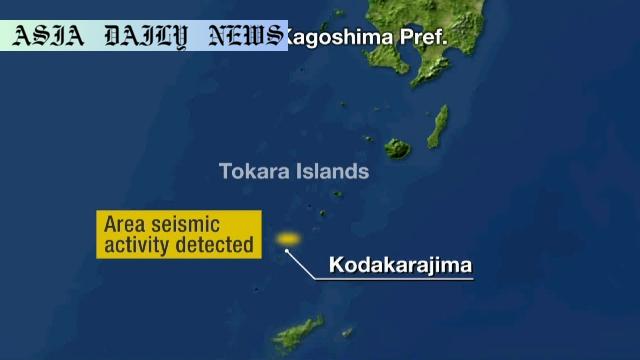Tremors – More than 500 tremors rattle Tokara island chain in southwestern Japan with intensity up to 4, raising seismic concerns.
More than 500 tremors shook southwestern Japan’s Tokara island chain.
Seismic activity peaked on Monday with 183 jolts of intensity 1 or higher.
Officials caution that intense activity could continue, though no tsunamis occurred.

Seismic Activity Intensifies in Southwestern Japan
The Tokara island chain in Japan’s Kagoshima Prefecture has experienced an unprecedented surge in seismic activity, as over 500 tremors have been recorded within just a week. The significant increase in seismic occurrences commenced on June 21, particularly concentrating around Kodakarajima Island. This cluster of islands, which encompasses Toshima Village, has felt the brunt of these tremors, many of which have been strong enough to be registered on the Japanese seismic scale.
Authorities report that 525 jolts with an intensity of 1 or higher were observed as of 5 p.m. on Saturday. These tremors included six with an intensity of 4 and 27 with an intensity of 3. Fortunately, there has been no tsunami linked to the ongoing seismic activities. Monday recorded the peak of this event, with an astounding 183 tremors of 1 or higher intensities.
Historical Perspective on the Tokara Region’s Seismic Patterns
Periods of intense seismic activity are not new to the Tokara region. Historical records indicate similar surges in the past, such as in September 2023, when 346 tremors of intensity 1 or higher rocked the area over 15 days. Another spike occurred in December 2021, featuring 308 jolts spread over 26 days. Such recurrent seismic activity in this region underscores its geological volatility, prompting persistent monitoring and readiness measures to ensure the safety and awareness of the residents and stakeholders.
Precautions and Implications for Residents of Tokara
As tremors persist, Japanese officials are urging residents and visitors in the affected areas to stay vigilant. The absence of a tsunami offers a degree of relief, yet the unpredictable nature of seismic events necessitates continuous caution. Emergency protocols, evacuation routes, and disaster preparedness are critical components of the region’s strategy to manage this geological activity. Understanding the local seismic landscape is imperative for long-term planning and the mitigation of risks posed by potential disasters.
Enhanced Monitoring and Scientific Research Efforts
Ongoing seismic activity has prompted enhanced monitoring efforts in the region. Geologists and researchers are closely examining patterns to assess the potential for further activity and its geological causes. The data collected from these events offers valuable insights into the tectonic mechanisms fueling the tremors. Additionally, these studies potentially contribute to the refinement of early warning systems, which are vital for mitigating the impact of future seismic events on the Tokara island chain and surrounding areas.
Final Thoughts on the Tokara Island Tremors
With over 500 tremors rattling the region, the situation in the Tokara island chain serves as a reminder of nature’s unpredictability. While no tsunamis have occurred, these seismic activities highlight the resilience required to thrive in tectonically active regions. As science and data collection evolve, communities must remain educated and prepared to face such challenges. Residents and authorities in the affected areas are urged to stay informed and proactive in the face of this ongoing phenomenon.
Commentary
The Vulnerability of Tectonically Active Regions
The recent surge of over 500 tremors in Japan’s Tokara island chain serves as a stark reminder of the vulnerability of communities situated in seismically active regions. Such areas are at the mercy of powerful natural forces, and this recent event underscores the importance of diligent monitoring and preparedness. While Japan is no stranger to earthquakes, the sheer volume and intensity of these tremors highlight the need for enhanced scientific research and governmental support to safeguard residents.
Learning from Historical Patterns
This increase in seismic activity is not without precedent, as indicated by past surges in 2021 and 2023. The key to navigating such occurrences lies in analyzing historical patterns and leveraging data to improve early warning systems. The Tokara region represents a valuable case study for geologists, offering crucial insights into the tectonic intricacies of Japan. With proper study and innovation, these episodes could lead to advancements that mitigate the impact of future seismic shocks.
Community Preparedness: A Lifesaving Priority
Despite the unpredictability of seismic events, community preparedness can play a crucial role in reducing risks and saving lives. From evacuation drills to infrastructure designed to withstand quakes, every step taken toward readiness makes a difference. I commend the efforts of Japanese authorities to provide timely updates and ensure the safety of residents. However, sustained education and investment in disaster prevention must remain a priority moving forward.
A Call for Resilience and Solidarity
In times of crisis, the resilience of communities is tested. The people of Tokara island chain, like countless others in tectonically active regions worldwide, embody this resilience. Their ability to adapt, coupled with the support of local and national authorities, offers a beacon of hope amid uncertainty. As scientists, policymakers, and communities work together, I am confident that the lessons learned from this surge of tremors will lead to stronger, more prepared societies in the future.


